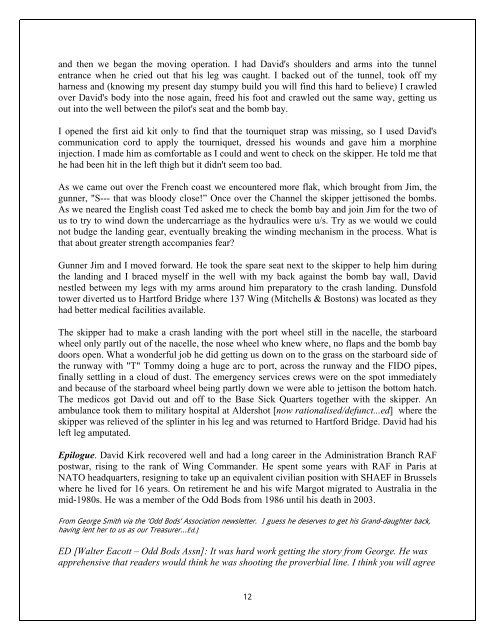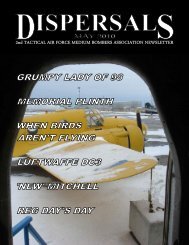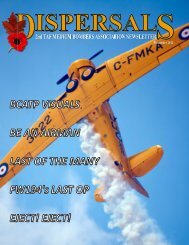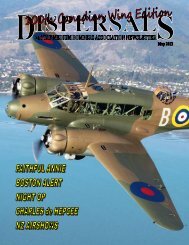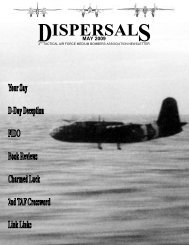November 2009 - Brussels Air Museum Foundation
November 2009 - Brussels Air Museum Foundation
November 2009 - Brussels Air Museum Foundation
Create successful ePaper yourself
Turn your PDF publications into a flip-book with our unique Google optimized e-Paper software.
and then we began the moving operation. I had David's shoulders and arms into the tunnel<br />
entrance when he cried out that his leg was caught. I backed out of the tunnel, took off my<br />
harness and (knowing my present day stumpy build you will find this hard to believe) I crawled<br />
over David's body into the nose again, freed his foot and crawled out the same way, getting us<br />
out into the well between the pilot's seat and the bomb bay.<br />
I opened the first aid kit only to find that the tourniquet strap was missing, so I used David's<br />
communication cord to apply the tourniquet, dressed his wounds and gave him a morphine<br />
injection. I made him as comfortable as I could and went to check on the skipper. He told me that<br />
he had been hit in the left thigh but it didn't seem too bad.<br />
As we came out over the French coast we encountered more flak, which brought from Jim, the<br />
gunner, "S--- that was bloody close!” Once over the Channel the skipper jettisoned the bombs.<br />
As we neared the English coast Ted asked me to check the bomb bay and join Jim for the two of<br />
us to try to wind down the undercarriage as the hydraulics were u/s. Try as we would we could<br />
not budge the landing gear, eventually breaking the winding mechanism in the process. What is<br />
that about greater strength accompanies fear<br />
Gunner Jim and I moved forward. He took the spare seat next to the skipper to help him during<br />
the landing and I braced myself in the well with my back against the bomb bay wall, David<br />
nestled between my legs with my arms around him preparatory to the crash landing. Dunsfold<br />
tower diverted us to Hartford Bridge where 137 Wing (Mitchells & Bostons) was located as they<br />
had better medical facilities available.<br />
The skipper had to make a crash landing with the port wheel still in the nacelle, the starboard<br />
wheel only partly out of the nacelle, the nose wheel who knew where, no flaps and the bomb bay<br />
doors open. What a wonderful job he did getting us down on to the grass on the starboard side of<br />
the runway with "T" Tommy doing a huge arc to port, across the runway and the FIDO pipes,<br />
finally settling in a cloud of dust. The emergency services crews were on the spot immediately<br />
and because of the starboard wheel being partly down we were able to jettison the bottom hatch.<br />
The medicos got David out and off to the Base Sick Quarters together with the skipper. An<br />
ambulance took them to military hospital at Aldershot [now rationalised/defunct...ed] where the<br />
skipper was relieved of the splinter in his leg and was returned to Hartford Bridge. David had his<br />
left leg amputated.<br />
Epilogue. David Kirk recovered well and had a long career in the Administration Branch RAF<br />
postwar, rising to the rank of Wing Commander. He spent some years with RAF in Paris at<br />
NATO headquarters, resigning to take up an equivalent civilian position with SHAEF in <strong>Brussels</strong><br />
where he lived for 16 years. On retirement he and his wife Margot migrated to Australia in the<br />
mid-1980s. He was a member of the Odd Bods from 1986 until his death in 2003.<br />
From George Smith via the ‘Odd Bods’ Association newsletter. I guess he deserves to get his Grand-daughter back,<br />
having lent her to us as our Treasurer...Ed.]<br />
ED [Walter Eacott – Odd Bods Assn]: It was hard work getting the story from George. He was<br />
apprehensive that readers would think he was shooting the proverbial line. I think you will agree<br />
12


